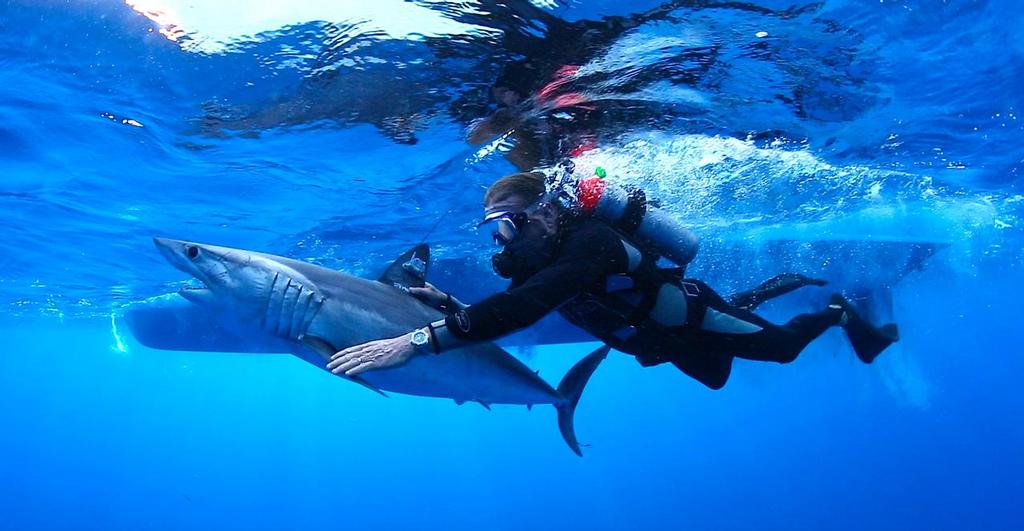Shark training program introduced at small Midwest school
by John Bell on April 4, 2014

Guy Harvey helps release tagged mako shark John Bell
The students of the Natural Science class at St. Mary Central join thousands of students from Florida to follow the migration patterns of mako, tiger, sandbar and oceanic white sharks on their daily journeys across the Atlantic Ocean, Caribbean Sea and Gulf of Mexico.
St. Mary is the first Midwest school to participate in the new Shark Education program originally created by the Guy Harvey Ocean Foundation for Florida schools, where students can study shark species, understand the important role sharks play in a healthy ecosystem of oceans and have the ability to track daily sharks that have been caught, tagged with satellite transponders and then released for further research and study.
As part of the Shark Ed program, St. Mary received classroom posters depicting 19 species of sharks, shark documentaries on DVD and a Skype classroom teaching session courtesy of the Guy Harvey Research Institute at Nova Southeastern University's South Florida-based Oceanographic Center.
“It's a great tool for teachers to use in the classroom to get students interested in science and marine science in particular,” said Antonio Fins, Executive Director of the Guy Harvey Ocean Foundation.
Finns said Guy Harvey reporter John Bell suggested an idea to take the program to students away from the ocean, and as a former St. Mary's Central student he recommended the Martins Ferry school as a test case.
“I think it works pretty well,” said the St. John's science teacher. Mary Central, Paul Steckler. “All four classes have really enjoyed the documentaries and we will be watching the sharks via computer link as well as creating the tutorial for more classroom instruction.”
Students as well as anyone interested can check the institute's interactive website Website to track tagged shark movements in near real time.
The site is an educational component of the institute's effort to study shark migration patterns, with the ultimate goal of better understanding and protecting them, as some species are threatened or endangered due to overfishing and the Asian market for shark fin soup.
Nova Southeastern University's Guy Harvey Research Institute began tagging mako sharks in 2009 to study their migratory patterns and now undertakes expeditions around the world to study them. The school's marine experts have tagged mako sharks as far away as Mexico and New Zealand. In addition to makos, GHRI and Save Our Seas Shark Research Center scientists are also monitoring tiger, oceanic white tip and sand sharks, as well as blue marlin.
Schools interested in the Shark Ed Program and receiving the “Sharks of the World” marine education posters should contact John Bell at prseitz@bellsouth.net.
About the Guy Harvey Research Institute at NSU: Established in 1999, the Guy Harvey Research Institute (GHRI) at NSU is a collaboration between renowned marine artist, scientist and explorer, Dr. Guy Harvey, and the Nova Southeastern University Oceanographic Center. GHRI's mission is to provide the scientific information needed to understand, conserve, and effectively manage the world's marine fishes and their ecosystems. GHRI is one of the few private organizations dedicated solely to the scientific conservation of marine fish populations and biodiversity. GHRI's research, education, and outreach activities are supported by the Guy Harvey Ocean Foundation, AFTCO Inc., extramural research grants, philanthropic donations from private businesses and individuals, and NSU.
If you want to link to this article, please use this URL: www.sail-world.com/120742



